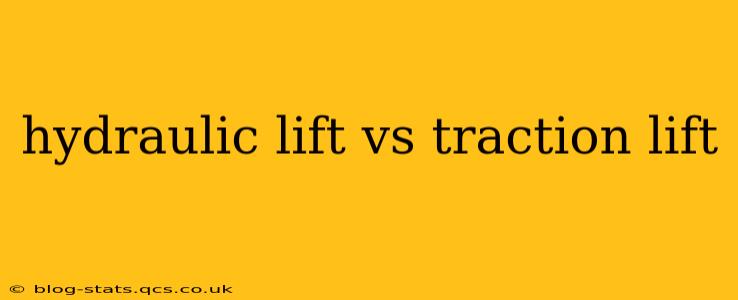Hydraulic Lift vs. Traction Lift: A Comprehensive Comparison
Choosing between a hydraulic lift and a traction lift for your elevator needs depends heavily on factors like building height, budget, and desired speed and capacity. Both systems accomplish the same goal—transporting people or goods vertically—but they achieve it using different mechanisms. This comparison will delve into the key differences, helping you understand which type is best suited for your specific requirements.
What is a Hydraulic Lift?
Hydraulic lifts utilize a hydraulic piston and cylinder system to move the elevator car. A pump pressurizes hydraulic fluid, forcing the piston to extend and raise the car. Conversely, releasing the pressure allows the car to descend, often aided by gravity. Think of it like a giant, powerful syringe lifting a platform.
Advantages of Hydraulic Lifts:
- Lower Initial Cost: Generally, hydraulic lifts are less expensive to install than traction lifts, particularly for low-rise buildings.
- Simpler Mechanics: Their simpler design often translates to easier maintenance and fewer potential points of failure.
- High Capacity: Hydraulic lifts can handle heavier loads than traction lifts of comparable size. This makes them ideal for freight elevators or applications requiring significant carrying capacity.
- Flexibility in Installation: They can be installed in smaller spaces, requiring less headroom than some traction lift systems.
Disadvantages of Hydraulic Lifts:
- Limited Height: They're less efficient for taller buildings. The length of the hydraulic piston limits the maximum travel distance. Excessively long pistons can become impractical and less reliable.
- Slower Speeds: Compared to traction lifts, hydraulic lifts generally operate at slower speeds.
- Environmental Concerns: Hydraulic systems utilize hydraulic fluid, which can pose environmental concerns if leaks occur. Modern systems are designed to minimize leakage, but it's a factor to consider.
- Energy Inefficiency: Hydraulic lifts can be less energy-efficient than traction lifts, especially in taller buildings.
What is a Traction Lift?
Traction lifts use a system of ropes, counterweights, and a motor to move the elevator car. The motor drives a sheave (a grooved wheel) that rotates, winding the ropes and lifting the car. A counterweight helps balance the car's weight, reducing the energy required for operation.
Advantages of Traction Lifts:
- Suitable for High-Rise Buildings: Traction lifts are the preferred choice for tall buildings due to their efficiency at greater heights.
- Faster Speeds: They can achieve significantly higher speeds than hydraulic lifts.
- Greater Energy Efficiency: Traction lifts are generally more energy-efficient, especially for taller structures.
- Smoother Rides: The counterweight system and sophisticated control systems often lead to smoother rides than hydraulic lifts.
Disadvantages of Traction Lifts:
- Higher Initial Cost: The more complex machinery and installation requirements result in higher initial investment costs.
- More Complex Maintenance: The intricate system of ropes, sheaves, and motors requires more specialized maintenance.
- Requires More Headroom: Traction lifts require more space above the elevator shaft for the machinery.
- Potentially Higher Ongoing Costs: Maintenance and repairs can be more expensive than for hydraulic lifts.
What are the Differences in Maintenance?
Hydraulic Lift Maintenance: Focuses on hydraulic fluid levels, pump operation, piston seals, and overall system leakage. Regular fluid changes and inspections are crucial.
Traction Lift Maintenance: Requires inspections of ropes, sheaves, brakes, motors, and the entire hoisting mechanism. Rope replacement is a regular maintenance requirement, along with lubrication and motor inspections.
Which Type is Right for Me?
The optimal choice depends on your specific needs:
- Low-rise buildings (up to 5-6 stories) with moderate capacity needs: A hydraulic lift is likely the more cost-effective option.
- High-rise buildings, speed is a priority, or significant energy efficiency is desired: A traction lift is the better choice.
- High-capacity requirements: Hydraulic lifts often provide greater load-bearing capabilities.
This decision should be made in consultation with an elevator professional who can assess your specific building requirements and provide expert advice based on your situation. Don't hesitate to seek multiple quotes and compare proposals before making a final choice.
